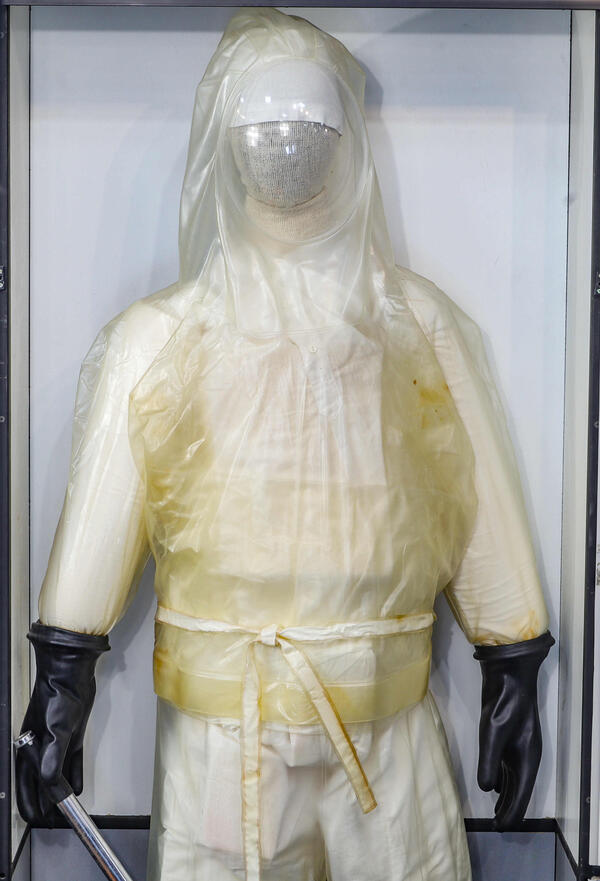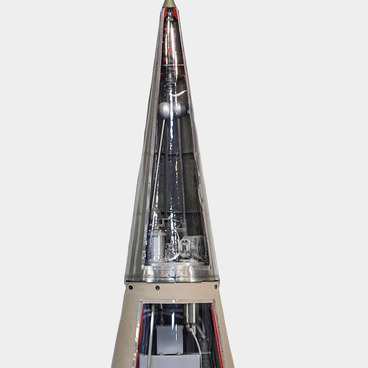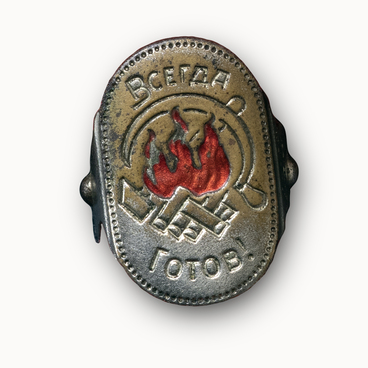An pressure suit is a special type of protective clothing used in the oil and gas, chemical and nuclear industries, as well as in the fire brigade and medical services. It protects against toxic substances, radioactive gases, temperature extremes and bacteria. A pressure suit features a constant supply of clean air under the helmet unlike a hazmat suit.
The LH-5 insulating pressure suit was developed in the 1950s. It weighs about 11 kilograms and consists of the suit itself and an air supply system for breathing and ventilation. Clean air flows in through a 20-meter-long rubber hose and out through a special valve. The constant air pressure between the body and the coverall provides an additional degree of isolation from the outside environment and conditions for gas, heat and moisture exchange.
The protective layer of the suit consists of a coverall and a rigidly fitted helmet. The sleeves are finished off with rings to which special gloves are attached hermetically. An opening to enter and leave the suit is located at the front. The maximum working time in the suit at temperatures from 0°C to +30°C is six hours. At temperatures from -10 to -20 °C the suit can be worn for no more than half an hour. Properties of polymeric material and sealed seams allow the LH-5 suits to be used repeatedly up to 10 times.
The pressure suit from the Museum of the History of Obninsk belonged to an employee of the world’s first nuclear power plant. It was launched in the summer of 1954 and operated for 48 years without accidents. To protect the plant operator from radioactive aerosols and dust, a helmet with a protective screen was welded to the coverall. Additional film covered that enveloped the upper torso, head and legs enhanced protection, and rubber overshoes on the worker’s feet were welded to the bottom of the trousers.
The modern LH-type pressure suits are not fundamentally different from their mid-20th century analogs. Today’s insulating suits are hermetically sealed and more comfortable, completed with insulating undergarments, intercom, camera and anti-fog lenses, and a new generation of polymers increases their level of protection.
The LH-5 insulating pressure suit was developed in the 1950s. It weighs about 11 kilograms and consists of the suit itself and an air supply system for breathing and ventilation. Clean air flows in through a 20-meter-long rubber hose and out through a special valve. The constant air pressure between the body and the coverall provides an additional degree of isolation from the outside environment and conditions for gas, heat and moisture exchange.
The protective layer of the suit consists of a coverall and a rigidly fitted helmet. The sleeves are finished off with rings to which special gloves are attached hermetically. An opening to enter and leave the suit is located at the front. The maximum working time in the suit at temperatures from 0°C to +30°C is six hours. At temperatures from -10 to -20 °C the suit can be worn for no more than half an hour. Properties of polymeric material and sealed seams allow the LH-5 suits to be used repeatedly up to 10 times.
The pressure suit from the Museum of the History of Obninsk belonged to an employee of the world’s first nuclear power plant. It was launched in the summer of 1954 and operated for 48 years without accidents. To protect the plant operator from radioactive aerosols and dust, a helmet with a protective screen was welded to the coverall. Additional film covered that enveloped the upper torso, head and legs enhanced protection, and rubber overshoes on the worker’s feet were welded to the bottom of the trousers.
The modern LH-type pressure suits are not fundamentally different from their mid-20th century analogs. Today’s insulating suits are hermetically sealed and more comfortable, completed with insulating undergarments, intercom, camera and anti-fog lenses, and a new generation of polymers increases their level of protection.




